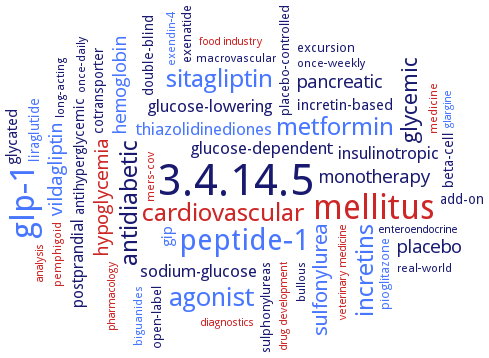3.4.14.5: dipeptidyl-peptidase IV
This is an abbreviated version!
For detailed information about dipeptidyl-peptidase IV, go to the full flat file.

Word Map on EC 3.4.14.5 
-
3.4.14.5
-
mellitus
-
glp-1
-
peptide-1
-
agonist
-
cardiovascular
-
sitagliptin
-
metformin
-
antidiabetic
-
incretins
-
glycemic
-
sulfonylurea
-
hypoglycemia
-
vildagliptin
-
monotherapy
-
hemoglobin
-
placebo
-
pancreatic
-
glucose-lowering
-
glucose-dependent
-
sodium-glucose
-
thiazolidinediones
-
insulinotropic
-
postprandial
-
glycated
-
incretin-based
-
gip
-
liraglutide
-
add-on
-
double-blind
-
beta-cell
-
cotransporter
-
antihyperglycemic
-
exenatide
-
excursion
-
open-label
-
placebo-controlled
-
pioglitazone
-
sulphonylureas
-
pemphigoid
-
long-acting
-
bullous
-
exendin-4
-
mers-cov
-
real-world
-
biguanides
-
once-daily
-
medicine
-
macrovascular
-
once-weekly
-
drug development
-
veterinary medicine
-
analysis
-
pharmacology
-
glargine
-
food industry
-
enteroendocrine
-
diagnostics
- 3.4.14.5
- mellitus
- glp-1
- peptide-1
- agonist
- cardiovascular
- sitagliptin
- metformin
-
antidiabetic
- incretins
-
glycemic
- sulfonylurea
- hypoglycemia
- vildagliptin
-
monotherapy
- hemoglobin
-
placebo
- pancreatic
-
glucose-lowering
-
glucose-dependent
-
sodium-glucose
- thiazolidinediones
-
insulinotropic
-
postprandial
-
glycated
-
incretin-based
- gip
- liraglutide
-
add-on
-
double-blind
- beta-cell
-
cotransporter
-
antihyperglycemic
-
exenatide
-
excursion
-
open-label
-
placebo-controlled
- pioglitazone
-
sulphonylureas
- pemphigoid
-
long-acting
-
bullous
- exendin-4
- mers-cov
-
real-world
- biguanides
-
once-daily
- medicine
-
macrovascular
-
once-weekly
- drug development
- veterinary medicine
- analysis
- pharmacology
- glargine
- food industry
-
enteroendocrine
- diagnostics
Reaction
release of an N-terminal dipeptide, Xaa-Yaa-/-Zaa-, from a polypeptide, preferentially when Yaa is Pro, provided Zaa is neither Pro nor hydroxyproline =
Synonyms
(GLP1)-degrading enzyme, ACT3, ADA binding protein, ADA-binding protein, ADABP, adenosine deaminase binding protein, Adenosine deaminase complexing protein, adenosine deaminase-binding protein, amino acyl-prolyl dipeptidyl aminopeptidase, aminopeptidase, glycylproline, Bile canaliculus domain-specific membrane glycoprotein, CD26, CD26 peptidase, CD26/dipeptidyl peptidase, CD26/DP IV, DAP IV, DapB, dapUm, dipeptidyl aminopeptidase IV, dipeptidyl dipeptidase IV, dipeptidyl peptidase 4, dipeptidyl peptidase 8, dipeptidyl peptidase 9, dipeptidyl peptidase IV, dipeptidyl peptidase-4, dipeptidyl peptidase-IV, dipeptidyl-aminopeptidase IV, dipeptidyl-peptidase 4, dipeptidyl-peptidase IV (CD26), dipeptidyl-peptide hydrolase, dipeptidylpeptidase 4a, dipeptidylpeptidase 4b, dipeptidylpeptidase IV, dipeptidylpeptidase IV/CD26, dipeptidylpeptidase-IV, DP IV, DP-IV, DPIV, DPP, DPP IV, DPP IV/CD26, DPP-4, DPP-IV, DPP4, DPP8, DPP9, DPPIV, DppIVA, DppIVB, glucagon-like peptide 1-degrading enzyme, Gly-Pro-naphthylamidase, glycoprotein GP110, glycylproline aminopeptidase, glycylproline-dipeptidyl-aminopeptidase, glycylprolyl aminopeptidase, glycylprolyl dipeptidylaminopeptidase, GP110 glycoprotein, h-DPPIV, hDPPIV, leukocyte antigen CD26, lymphocyte, antigen CD26, More, omega DPPIV, omega enzyme, omega gene product, Pep X, peptidase, dipeptidyl, IV, PepX, postproline dipeptidyl aminopeptidase IV, prolyl-dipeptidyl-aminopeptidase, sipeptidyl peptidase IV, T cell triggering molecule Tp103, T-cell activation antigen CD26, THAM, Thymocyte-activating molecule, TP103, type IV dipeptidyl aminopeptidase, WC10, X-PDAP, X-prolyl dipeptidyl aminopeptidase, X-prolyl-dipeptidyl aminopeptidase, Xaa-Pro-dipeptidyl-aminopeptidase


 results (
results ( results (
results ( top
top





